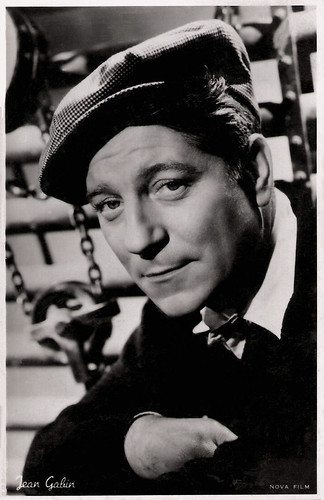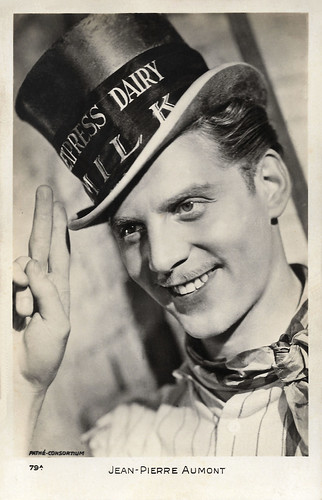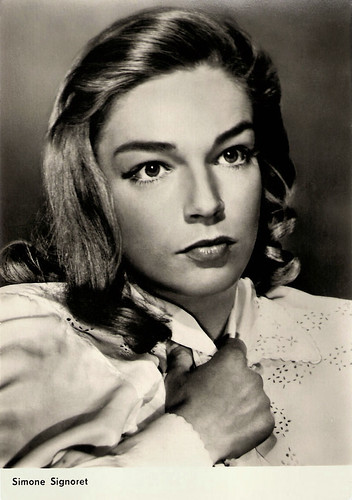
Dutch postcard by M. B. & Z., no. 1206. Photo: Raymond Voinquel / Nova Film. Jean Gabin in Le jour se lève/Daybreak (Marcel Carne, 1939).

Swiss-German-British postcard by News Productions, Baulmes / Filmwelt Berlin, Bakede / News Productions, Stroud, no. 56510. Photo: Collection Cinémathèque Suisse, Lausanne. Michel Simon and Jean-Louis Barrault in Drôle de Drame/Bizarre, Bizarre (Marcel Carné, 1937), produced by Comiglion-Molinier.

French postcard by Editions La Malibran, Paris / Saint Dié, no. CF 49. Photo: Eugen Schüfftan / Louis Page. Jean Gabin and Michèle Morgan in Le Quai des Brumes/Port of Shadows (Marcel Carné, 1938).

French postcard by Fernand Hazan, no. E 5. Photo: Roger-Carlet. Jean-Louis Barrault and Maria Casarès in Les enfants du paradis (Marcel Carné, 1945).

Dutch postcard by Takken, Utrecht, no. 4068. Photo: N.V. Standaardfilms, Amsterdam. Pascale Petit in Les Tricheurs/Youthful Sinners (Marcel Carné, 1958).
One of the most important French filmmakers of the 1930s
Marcel Carné was born in Paris, France, in 1906. He was the son of Marcelin Paul Carné, a cabinet maker, and Véronique Marie Françoise Racouët. His mother died when he was five years old, and Marcel was brought up by his grandmother and an aunt. He was soon drawn to the cinema: every Thursday he went to a film screening, and then more and more often. After attending an arts and crafts school and completing his military service, he first worked as an insurance agent. He secretly took evening classes in photography at the Ecole des Arts et Métiers, graduating as a photography technician.
Carné entered the film industry in the silent era as a camera technician. He also began writing film reviews for Parisian magazines like Cinémagazine and Cinémonde. After a meeting with actress Françoise Rosay, Carné was hired as a secondary assistant director for her husband Jacques Feyder's new film, Les Nouveaux Messieurs (Jacques Feyder, 1928). Feyder became his artistic mentor. The following year, the 23-year-old Carné made Nogent (Marcel Carné, 1929), a short documentary about the Sunday escapades of young Parisians, shot with a hand-held camera.
He visited the USA as a film critic. Back in France, he became assistant director to René Clair for Sous les toits de Paris/Under The Roofs Of Paris (1930), and to Jacques Feyder for Le Grand Jeu/The Great Game (1934), Pension Mimosas (1935) and La kermesse héroïque/Carnival In Flanders (1935). Feyder introduced him to Jacques Prévert. The surrealist poet and film writer became a lifelong friend of Carné and wrote the screenplay for his first feature, Jenny (Marcel Carné,1936), starring Jean-Louis Barrault and Feyder's wife, Françoise Rosay. Carné's breakthrough came with his second film, the crime comedy Drôle de Drame/Bizarre, Bizarre (Marcel Carné, 1936), starring Louis Jouvet and Michel Simon. Prévert had also written the screenplay for this film.
Their films Le Quai des Brumes/Port of Shadows (Marcel Carné, 1938) and Le jour se lève/Daybreak (Marcel Carné, 1939), in which Jean Gabin played the leading role, made Carné one of the most important French filmmakers of the 1930s alongside Jean Renoir, René Clair and Julien Duvivier. Le Quai des brumes (Marcel Carné, 1938), marked an important turning point in Carné and Prévert’s collaboration. Carné's skill in depicting exteriors and directing actors combined with Prévert's combining themes of late surrealism with a restless atmosphere created the film's charm. It is a prime example of Poetic Realism. A typical French genre of the late 1930s characterised by a ‘preference for the darker side of life, sympathy for the disadvantaged, attention to social problems, especially the conflict between the individual and society and the positioning of the characters in a specific milieu. Carné’s films in this genre also revealed an insurmountable pessimistic attitude to life.
Another example was Hôtel du Nord (Marcel Carné,1938) starring Louis Jouvet, Arletty and Annabella. Carné initially thought of Prévert to write the screenplay, but he was busy with other projects. The screenplay was written by Jean Aurenche and Henri Jeanson. Jouvet and Arletty are remembered as French cinema's most iconic pairing with their darkly comic bickering making up the more memorable moments of the film. Another highlight of Poetic Realism is Le jour se lève/Daybreak (Marcel Carné, 1939). It tells the story of a factory worker (Jean Gabin) who, just as he is about to be arrested by the police in his bedroom, relives the moments that led him to kill for love. When the sun rises, he shoots himself.

French postcard by Chantal, Paris, no. 79A. Photo: Pathé-Consortium. Jean-Pierre Aumont in Drôle de drame/Bizarre, Bizarre (Marcel Carné, 1937).

French postcard by Viny, no. 16. Photo: Les Films Osso. Michèle Morgan in Le Quai des Brûmes/Port Of Shadows (Marcel Carné, 1938).

French postcard by Editions Hazan, Paris, 1990, no. 6234. Arletty and Louis Jouvet in Hôtel du Nord (Marcel Carné, 1938).

French postcard by Edit. Chantal, Rueil (S.-O.), no, 49B. Photo: Raymond Voinquel / Sigma. Jean Gabin in Le jour se lève/Daybreak (Marcel Carne, 1939).

French postcard by E.C. Paris, no. 58. Photo: Aldò Graziati / Discina. Alain Cuny in Les visiteurs du soir/The Devil's Envoys (Marcel Carné, 1942).
Child of paradise
During the occupation of France by Nazi Germany in World War II, Marcel Carné's films were banned. He managed to shoot the medieval legend Les visiteurs du soir/The Devil's Envoys (Marcel Carné, 1942) starring Arletty and Alain Cuny in the zone of the Vichy government. Several of his team were Jewish, including Joseph Kosma and set designer Alexandre Trauner.
Between 1943 and 1945, Carné directed under difficult conditions Les enfants du paradis/Children Of Paradise (Marcel Carné, 1945), a clear anti-Nazi parable that was released after the liberation of France. Set in 19th-century Paris on the Boulevard du Crime, the film tells about a famous mime, Jean-Gaspard Deburau (Jean-Louis Barrault), and a great actor, Frédérick Lemaître (Pierre Brasseur), from the start of their careers to stardom and the love they both have for the beautiful Garance (Arletty). The film became a huge box-office success and an all-time classic of French cinema.
Carné and Prévert followed this triumph with what at the time was the most expensive production ever undertaken in the history of French film. But the result, the mystery Les Portes de la nuit/Gates Of The Night (Marcel Carné, 1946) starring Pierre Brasseur, Serge Reggiani and Yves Montand, was panned by the critics and a box-office failure. It was the last completed film of Carné and Prévert. Their Poetic Realism gave way to new forms of expression.
From the 1950s onwards. Carné alternated highs and lows. The critics of Cahiers du cinéma, who became the filmmakers of the New Wave, dismissed him and placed his films' merits solely with Prévert. However, the Émile Zola adaptation Thérèse Raquin/The Adultress (Marcel Carné, 1953) with Simone Signoret and Raf Vallone was screened at the 14th Venice International Film Festival where it won the Silver Lion. Carné was jury president of the first Berlinale in 1956 and he scored another box office success with Les tricheurs/Youthful Sinners (Marcel Carné, 1958) starring Jacques Charrier, Pascale Petit and Laurent Terzieff. The study of disaffected youth was the fifth biggest hit of the year in France.
In the 1960s, Carné found it increasingly difficult to get his films produced. He was forced to re-edit Les jeunes loups/The Young Wolves (Marcel Carné, 1968) with Yves Beneyton, and the main character's bisexuality was completely cut from the film. Carné himself was openly gay. His partner was actor Roland Lesaffre, who appeared in many of his films. Some of Carné’s later films contain references to male homosexuality or bisexuality: the ambiguous relationship between Jean Gabin and Roland Lesaffre in L'air de Paris/The Air of Paris (Marcel Carné, 1954) or Laurent Terzieff's character in Les tricheurs/Youthful Sinners (Marcel Carné, 1958). Carné ended his career with the documentary La Bible/The Bible (Marcel Carné, 1977). In 1979, he was the first film director to be elected to the French Académie des Beaux-Arts. Marcel Carné died in 1996 in Clamart, France, at the age of 90. He was buried in the Cimetière Saint-Vincent on Montmartre in Paris. Roland Lesaffre was buried in the same grave in 2009. Edward Baron Turk published a biography of Carné, ‘Child of Paradise: Marcel Carné and the Golden Age of French Cinema’ (1989).

Czech postcard by Czekoslovenské filmové naklatefstvi (CSFN), Praha, no. 99. Photo: Pathé Cinema. Arletty and Jean-Louis Barrault in Les Enfants du Paradis/Children of Paradise (Marcel Carné, 1945). Collection: Marlene Pilaete.

French postcard by Fernand Hazan, no. E 2. Arletty in Les enfants du paradis/Children of Paradise (Marcel Carné, 1945).

Swiss postcard by News Productions, Baulmes / Stroud, Filmwelt Berlin, Bakede, no. 56504. Photo: Collection Cinémathèque Suisse, Lausanne / Pathé Cinema. Jean-Louis Barrault in Les enfants du paradis/Children of Paradise (Marcel Carné, 1945).

French postcard by A. Noyer, Paris, no. 1232. Photo: Raymond Voinquel. Yves Montand at the time of Les Portes de la nuit/Gates Of The Night (Marcel Carné, 1946).

East-German postcard by VEB Progress Film-Vertrieb, no. 1924. Photo: Simone Signoret in Therese Raquin Thérèse Raquin/The Adultress (Marcel Carné, 1953).

East-German postcard by VEB Progress Film-Vertrieb, Berlin, no. 1925. Retail price: 0,20 DM. Photo: Raf Vallone and Simone Signoret in Thérèse Raquin/The Adultress (Marcel Carné, 1953).

Dutch postcard by Uitg. Takken, Utrecht, no. AX 4069. Photo: NV Standaardfilms, Amsterdam. Jacques Charrier and Pascale Petit in Les Tricheurs/Youthful Sinners (Marcel Carné, 1958).

Dutch postcard by Internationale Filmpers, Amsterdam, no. WPS 32, for Song Parade. Pascale Petit in Les Tricheurs/Youthful Sinners (Marcel Carné, 1958).

French postcard in the Encyclopédie du Cinéma series by Carterie Artistique et cinématographique, Pont du Casse, no. EDC 859 Vis. 2. Poster by Cechetto for Pathé Consortium Cinéma. French Affiche for Drôle de Drame/Bizarre, Bizarre (Marcel Carné, 1937), starring Françoise Rosay, Michel Simon, Jean-Louis Barrault, Jean-Pierre Aumont and Louis Jouvet.

French postcard. Design by (Harry) Bedos & Cie, Paris. Original French Affiche for Le Quai des brûmes/Port of Shadows (Marcel Carné, 1938).

French postcard in the Encyclopédie du Cinéma series by Carterie Artistique et cinématographique, Pont du Casse, no. EDC 602 Vis. 3. Design by S.P.M. for Films Osso. Original French Affiche for Le Quai des brûmes/Port of Shadows (Marcel Carné, 1938).

French postcard by Editions du Centre Pompidou and Flammarion, 1994 / Affiches Gaillard, Paris. Design by Jacques Bonnaud for Pathé Consortium Cinéma. Original French affiche for Les enfants du paradis. I. Le boulevard du crime (Marcel Carné, 1943-1945).

French postcard in the Collection Kharine-Tapabor. Design: Pathé Consortium Cinéma. Original French affiche for Les Enfants du Paradis (Marcel Carné, 1942-1945).
Sources: Volker Boehm (IMDb), Wikipedia (Dutch, German, French and English) and IMDb.
No comments:
Post a Comment